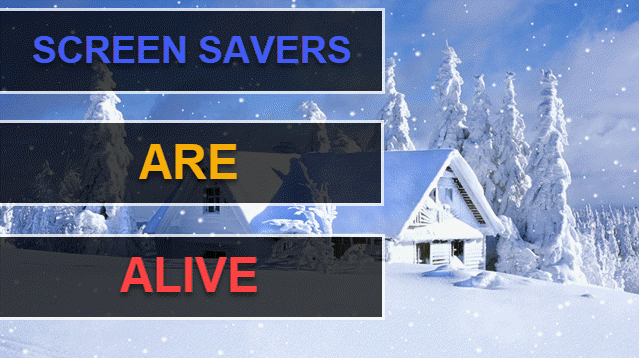
The History of Screen Savers
Screen savers originated in the early 1980s to address a technical limitation of cathode-ray tube (CRT) monitors. The first publicly released screensaver package that contained distinct, configurable displays… was the “Magic ScreenSaver” for Windows 2.0, first released in 1988 by Bill Stewart and Ian Macdonald as a piece of shareware.
Why Were Screen Savers Needed?
- Screen Burn-In: Prolonged static images could “burn” into CRT screens, leaving permanent ghost-like impressions.
- Preservation: Moving images helped prevent this phenomenon, extending monitor lifespan.
Early Screen Savers
The first screen savers were simple animations like bouncing dots or basic patterns. They served a purely functional role, ensuring no single image remained static for too long.
Evolution in the 1990s
As personal computers became more common, screen savers took on an artistic and entertainment-oriented role:
- Popular animations included flying toasters, maze games, and colorful kaleidoscopic patterns.
- Microsoft Windows included iconic screen savers like “3D Pipes” and “Starfield Simulation.”
Do Screen Savers Still Have a Purpose?
Modern display technologies, such as LCD and OLED screens, have largely eliminated the burn-in issues that plagued CRT monitors, reducing the practical need for screen savers. However, if you enjoy having an animated display while your computer is idle or simply appreciate the visual appeal of a screen saver, there’s no harm in using one—it’s entirely a matter of personal preference.
Current Uses
- Personalization: Many users still enjoy the aesthetic appeal of animated screensavers.
- Idle Displays: Digital signage and public screens often use them to display information or branding.
- Energy Saving: Power-saving modes have largely replaced screen savers for reducing energy consumption.
Relevance in Modern Times
- Screen savers are now more of a nostalgic feature than a necessity.
- They are often used for entertainment or as a visual showcase in home and office environments.
Top Screensaver Websites
If you’re looking to download screensavers, here are some reputable websites offering a variety of options. Below, you’ll find details about each site along with their pros and cons to help you choose the best one.
Screensavers Planet
Offers a vast collection of free screensavers for Windows and Mac, all tested to be free from adware and viruses.
Pros:
- Wide variety of screensavers available.
- Safe downloads—free from malware or adware.
- Regularly updated with new options.
Cons:
- Limited customization options for some screensavers.
- Not all screensavers are compatible with older systems.
FullScreensavers.com
Provides a range of free screensavers across categories like 3D, nature, and holidays.
Pros:
- Offers category-based screensavers for all tastes.
- Free to download with no subscription required.
Cons:
- Website design can feel outdated.
- Occasional pop-up ads during downloads.
Microsoft Store
Features applications like “Screen Saver Gallery” and “Lively Wallpaper,” allowing you to set dynamic wallpapers and screensavers.
Pros:
- High-quality, dynamic options with modern visuals.
- Direct integration with Windows for easy setup.
Cons:
- Requires a Microsoft account to download apps.
- Most options are not free.
Important Security Tip
Always ensure you download screensavers from trusted sources to protect your computer from malware or other security risks.
Conclusion
Screen savers have come a long way from their humble beginnings as a solution to screen burn-in. While their original purpose has faded with advancements in display technology, they continue to serve as a charming reminder of computing’s early days. Whether you use them for nostalgia, decoration, or idle display, screen savers still hold a small, unique place in our digital lives.
An Amazon’s Choice and the #1 Top Seller, the Aura Digital Picture Frame has delighted millions of customers. With 12,183 ratings, an impressive 4.7 out of 5 stars, and over 8,000 units sold in the past month, this frame is a must-have for your home or as the perfect gift. Available now for just $139.00.
Recommended by The New York Times/Wirecutter, Wired, and featured on Oprah’s Favorite Things, the Aura Digital Picture Frame makes sharing and displaying photos with loved ones incredibly easy.
Send photos and videos directly from your phone to the frame in seconds using the Aura app. With free, unlimited storage, there are no fees, making this a hassle-free way to keep memories alive. The sleek design fits any home decor and comes with crystal-clear image quality to highlight every cherished moment.
Join the millions of happy customers who call Aura “a game-changer for photo sharing.” Order yours now for $139.00 on Amazon!
Support Techcratic
If you find value in Techcratic’s insights and articles, consider supporting us with Bitcoin. Your support helps me, as a solo operator, continue delivering high-quality content while managing all the technical aspects, from server maintenance to blog writing, future updates, and improvements. Support innovation! Thank you.
Bitcoin Address:
bc1qlszw7elx2qahjwvaryh0tkgg8y68enw30gpvge
Please verify this address before sending funds.
Bitcoin QR Code
Simply scan the QR code below to support Techcratic.

Please read the Privacy and Security Disclaimer on how Techcratic handles your support.
Disclaimer: As an Amazon Associate, Techcratic may earn from qualifying purchases.



















































![[SWTT] Generative Art NFT Tutorial](https://techcratic.com/wp-content/uploads/2025/07/1752552896_maxresdefault.jpg)














































